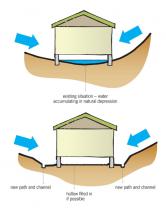Subfloor moisture
All ground releases water vapour, even when it looks as if it is dry on the surface.
Some sites have high groundwater or a high water table or springs.
Naturally occurring water under a house may be added to by:
- leaking water pipes or gully traps or defective waste pipes
- downpipes discharging rainwater under the floor
- leaks from wet areas inside the house
- surface water from surrounding ground flowing under the building
- water wicking up through brick or concrete masonry foundations.
If there is a visible water source under the house such as a leak in a pipe, then fixing the pipe is the obvious solution. Work on wastewater pipes must be carried out by a licensed plumber.
Where water is flowing under the building from higher ground, then some landscaping will be required. NZS 3604:2011 Timber-framed buildings requires a clear horizontal separation of not less than 450 mm between the outside of any wall cladding and any adjacent rising ground, with suitable drainage. Land or paving immediately around a house should be graded so rainwater runs away from the building, with adequate drainage to a stormwater disposal system.
If you can’t see how to resolve the problem, consult a New Zealand Institute of Building Surveyors (NZIBS) building surveyor.
One solution is to lay a polythene sheet ground cover over the whole subfloor area. The polythene should be a minimum 0.25 mm thick and lapped 150 mm at the joints. It must be butted against foundation walls and piles and weighed down with bricks or rocks to stay in place. The ground under it must be shaped so that water drains to the outside and does not allow water to pond on the ground cover.
Under the standard NZS 3604 (6.14.3), polythene ground cover is a requirement where:
- ventilation openings of 3500 mm2/m2 of floor area are not possible, or
- airflow is obstructed, or
- any part of the space is more than 7.5 m from an opening.
While dealing with sources of subfloor moisture is the first part of maintaining a healthy subfloor, ensuring effective ventilation is the next.



